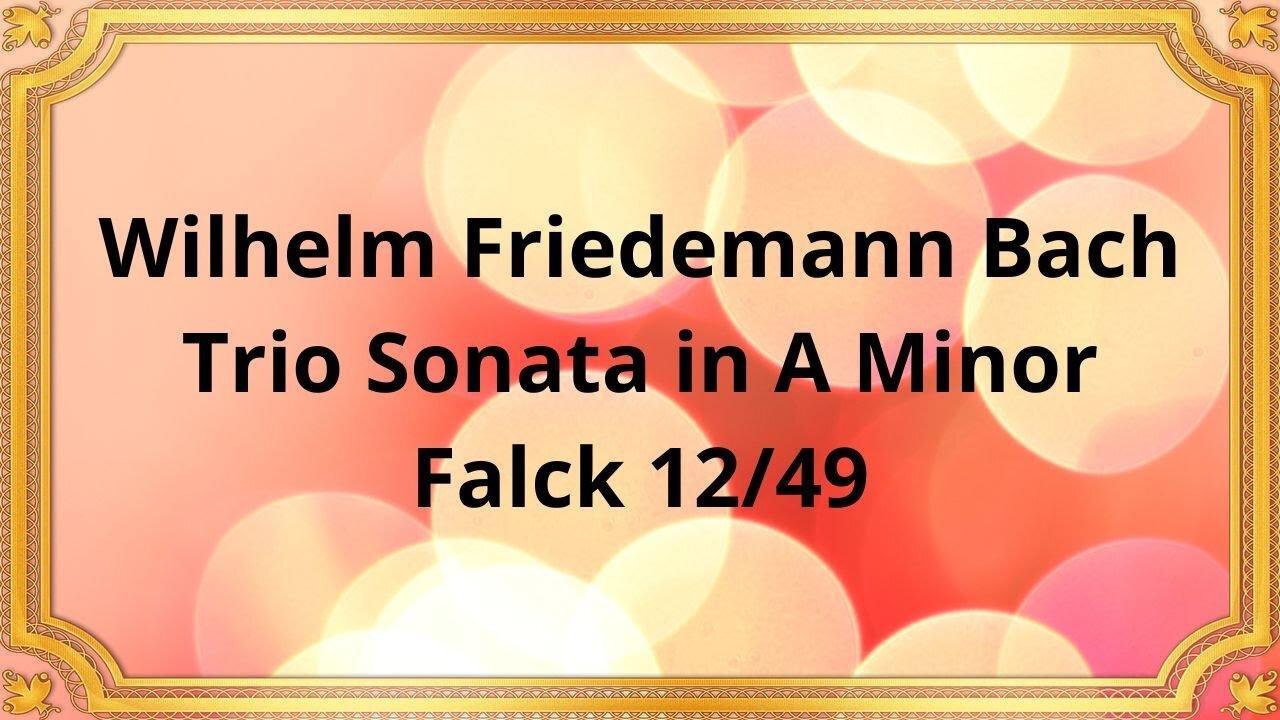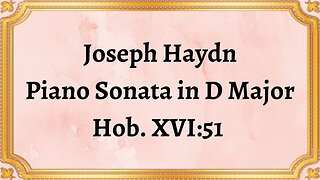Premium Only Content

Wilhelm Friedemann Bach Trio Sonata in A Minor, Falck 12/49
#WilhelmFriedemannBach #TrioSonata #AMinor #Falck1249 #ClassicalMusic #MusicalComposition #BaroqueEra #BachFamily #ChamberMusic #SonataForm #BaroqueMasterpiece #MusicHistory #ComposerSpotlight #InstrumentalMusic #BachLegacy
Gerhard REHM & Eberhart DASCHLER, Flutes
Holger RUCK TESCHLER, Bassoon
Friedrich DOLD, Harpsichord
Wilhelm Friedemann Bach's Trio Sonata in A Minor, Falck 12/49, is a captivating musical composition that showcases the brilliance and artistry of this influential composer from the Bach family. As a significant figure of the Baroque era, Wilhelm Friedemann Bach's Trio Sonata combines intricate counterpoint, expressive melodies, and dynamic textures to create a truly remarkable musical experience.
Wilhelm Friedemann Bach, the eldest son of Johann Sebastian Bach, composed the Trio Sonata in A Minor during the mid-18th century. At that time, the Baroque era was flourishing, characterized by elaborate compositions and contrapuntal textures. This sonata reflects the musical style of the period while showcasing Wilhelm Friedemann Bach's unique compositional voice. It stands as a testament to the rich musical heritage of the Bach family.
The Trio Sonata in A Minor, Falck 12/49, is a four-movement work that exemplifies the intricate beauty and technical prowess of Baroque chamber music. The piece is written for two melodic instruments and continuo, typically performed on two violins or flute, accompanied by harpsichord or basso continuo.
The first movement, marked Allegro, introduces a captivating and energetic theme, setting the stage for the ensuing musical journey. Through a masterful display of counterpoint, the intertwining melodies of the two instruments create a rich tapestry of sound.
The second movement, marked Andante, provides a contrasting mood with its lyrical and expressive melodies. The interplay between the two melodic lines evokes a sense of intimacy and introspection.
The third movement, marked Vivace, brings a lively and spirited character to the sonata. It showcases the technical virtuosity of the performers through its rapid passages, intricate ornamentation, and playful exchanges between the instruments.
The final movement, marked Allegro, serves as a triumphant conclusion to the sonata. It is filled with energetic flourishes, lively dialogue between the instruments, and a sense of joyful resolution.
Wilhelm Friedemann Bach's Trio Sonata in A Minor, Falck 12/49, remains a revered piece within the chamber music repertoire. Its intricate counterpoint, expressive melodies, and dynamic contrasts continue to captivate listeners and inspire performers. The sonata stands as a testament to Wilhelm Friedemann Bach's skill as a composer, showcasing his ability to craft engaging and emotionally charged musical works.
Conclusion:
The Trio Sonata in A Minor, Falck 12/49, by Wilhelm Friedemann Bach represents a magnificent example of Baroque chamber music. Through its intricate counterpoint, expressive melodies, and vibrant textures, this sonata offers a glimpse into the rich musical heritage of the Bach family.
You have the opportunity to support the channel:
https://destream.net/live/RadSiarAl/donate
https://www.buymeacoffee.com/6355radsiaral
-
 6:07
6:07
Classical music_Music Inspiration
5 days agoJoseph Haydn Piano Sonata in D Major, Hob. XVI:51
331 -
 3:06:08
3:06:08
Laura Loomer
4 hours agoEP 97: Trump's Nominees Transform America
50.1K15 -
 1:03:00
1:03:00
Man in America
12 hours agoThe Helicopter Crash DOESN'T MAKE SENSE... What REALLY Happened???
35.9K54 -
 55:11
55:11
Flyover Conservatives
1 day agoParents WIN, Teachers Unions PANIC! 3 Huge Education Bombshells This Week! - Corey DeAngelis | FOC Show
34.6K -
 1:40:20
1:40:20
Glenn Greenwald
8 hours agoTulsi's Hearing Exposes Bipartisan Rot of DC Swamp | SYSTEM UPDATE #400
95.4K191 -
 1:19:48
1:19:48
Simply Bitcoin
13 hours ago $8.03 earnedJerome Powells MASSIVE Bitcoin Backflip! | EP 1172
70.9K5 -
 58:42
58:42
The StoneZONE with Roger Stone
5 hours agoLBJ + CIA + Mob + Texas Oil = JFK Murder | The StoneZONE w/ Roger Stone
52.4K27 -
 58:00
58:00
Donald Trump Jr.
12 hours agoBreaking News on Deadly Plane Crash, Plus Hearing on the Hill, Live with Rep Cory Mills & Sen Marsha Blackburn | TRIGGERED Ep.212
184K139 -
 52:03
52:03
Kimberly Guilfoyle
11 hours agoLatest Updates on Deadly Air Collision, Plus Major Hearings on Capitol Hill,Live with Marc Beckman & Steve Friend | Ep.192
104K33 -
 1:17:16
1:17:16
Josh Pate's College Football Show
9 hours ago $1.59 earnedMichigan vs NCAA | ESPN’s ACC Deal | Season Grades: UGA & Miami | Notre Dame Losses
43.6K2